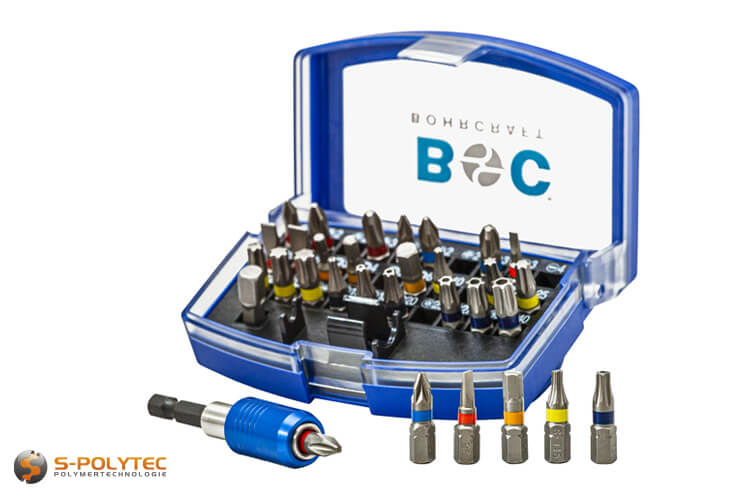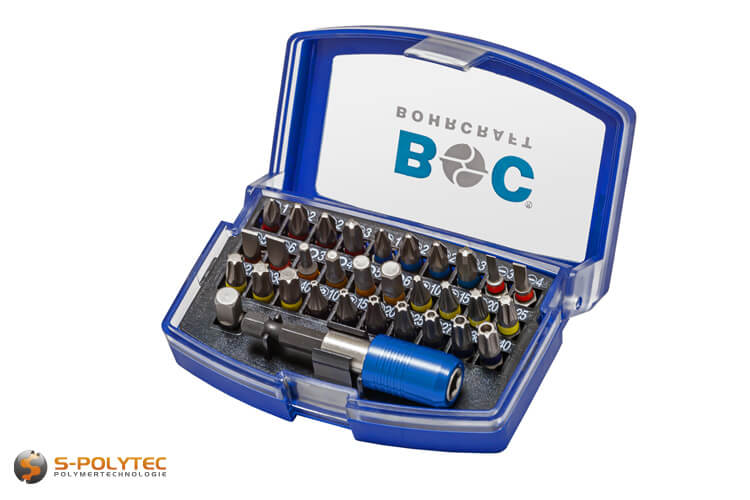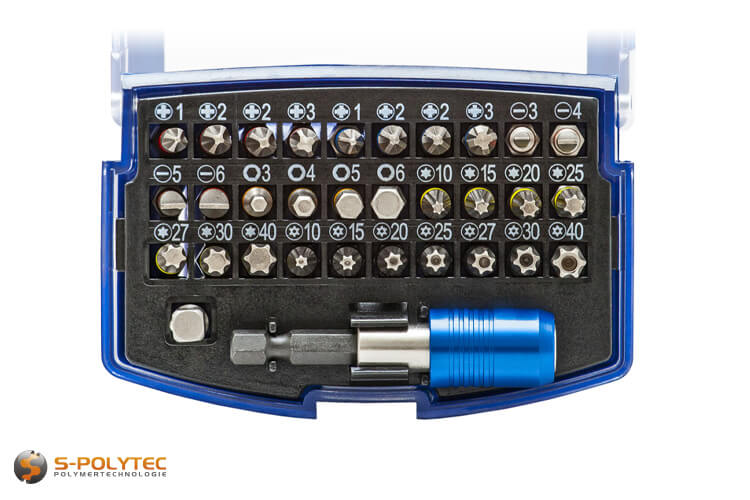
Professional bit set with bit holder (32 pieces)
With the professional bit set from Bohrcraft, the right bit attachment is always at hand without a long search - the 32-piece set contains a variety of the most important bit attachments, which always find a safe place for storage in the robust transport box.
✓ Colour ring marking
✓ Magnetic bit holder
✓ For all cordless screwdrivers
✓ For all common screws
✓ Transport box made of ABS plastic
The colour-coded bit attachments are made of very high-quality S2 steel.
The item is in stock
Dispatch within 2-3 working days
- calculate the price
€15.90 / pc.
0,2900 kg / pc.
All prices include 19% VAT.
- Description
Professional bit set in practical box - always the right bit at hand
High-quality tool steel ✓ With coloured ring marking ✓ Incl. magnetic bit holder ✓
With the Bohrcraft professional bit set, the right bit is always at hand. The bit set, consisting of 30 bits made of durable S2 steel, a square adapter for sockets and a bit holder with lock, is suitable for all cordless screwdrivers and drills with a drill chuck. With increasingly powerful cordless screwdrivers (e.g. from Makita, Metabo or Bosch Professional), which are already affordable even for the ambitious do-it-yourselfer, it is advisable to use tool bits that can withstand the high torques. Our high-quality bit set can absolutely meet this requirement and is therefore ideal for heavy use by craftsmen in the building trade, industry and DIY enthusiasts with a high awareness of quality.
The 32-piece set consists of 30 high-quality bits in the most common drives and sizes. In addition to simple slotted bits, it also includes cross-slotted bits for Phillips screws and Pozidriv screws in the most common sizes. The set also includes hexagon socket bits and hexagon socket bits with a hole, which most people are familiar with under the brand name TORX® or TORX-TR®. For screws with a hexagon socket drive, which are also referred to in common parlance under the brand name Inbus®, the bits are available in the usual market sizes. For easy and quick changing of the bits, the bit set also includes a magnetic bit holder, which has a practical locking mechanism so that the bits do not constantly fall out of the bit holder when screwing. A square adapter for sockets with an inch socket completes the comprehensive set.
The practical box made of robust ABS plastic should not be missing from any cordless screwdriver and is used for easy storage of the bits so that they do not fly around loose in the screwdriver case or get lost. The slots for the individual bits have a good grip and make it easy to remove the required bit. In order to have the right bit quickly at hand, all slots are marked with a graphic representation indicating the corresponding size. Thanks to the rotating belt clip, the handy box can be easily attached to the belt. This way, all screwdriver bits are always at hand when screws with different drives are used for screwing or disassembly work.
-
Scope of delivery:
- 1 x 32 pcs. bit box with magnetic bit holder
NOTE: The bit box includes 30 bits of the six most common screw profiles in different sizes, a square adapter and a quick-change bit holder.
Overview of the included tool bits
- Cross slot (Phillips®): 1x PH1, 2x PH2, 1x PH3
- Cross slot (Pozidriv®): 1x PZ1, 2x PZ2, 1x PZ3
- Slot: 1x each SL3, SL4, SL5, SL6
- Inner hexagon round (Torx®): 1 x each T10, T15, T20, T25, T27, T30, T40
- Inner hexagon round (Torx-TR®): 1 x each TH10, TH15, TH20, TH25, TH27, TH30, TH40
- Internal hexagon (Allen®): 1 x each HEX3, HEX4, HEX5, HEX6
NOTE:The brand names in brackets are the screw profiles for which the bits can be used.
Meaning of the colour coding of screwdriver bits
High-quality bits are marked with a coloured ring by most well-known manufacturers to make it easier for users to choose the right bit attachment. However, the colours are not standardised and can vary from manufacturer to manufacturer. With one manufacturer, a screwdriver bit for Phillips screws may be marked with a blue ring, while with another manufacturer the blue coloured ring stands for Pozidriv screws. There are even manufacturers of bit sets who use different colours for their bits in the set, even if they have the same screw drive. Here, the coloured rings are usually used to identify the bit size. In our case, all bits that are suitable for the same screw profiles, regardless of size, are coded with a uniform colour ring, as used by some manufacturers in a similar way.
An orange coloured ring identifies bits for conventional slotted screws
The four slotted bits in the set are all marked with a coloured ring in orange and are suitable for all normal slotted screws, regardless of whether they are threaded screws or wood screws. The shape of the screw head is also irrelevant. Slotted screws were among the first mass-produced screws that could be screwed in with an insertion tool and are still used today in countless areas.
A red coloured ring indicates bits for Phillips head screws
Phillips screws were developed in the early 1930s and owe their name to the inventor Henry Phillips. These had the advantage that the internal cross-slot drive prevented the screwdriver from slipping out of the previously common slotted screws and enabled a higher torque for tighter fastenings. The four bits for Phillips screws included in the bit set are marked with a red coloured ring. The most common size PH2 is included in the set twice, because this bit is most frequently used for screws with a Phillips drive. A very well-known example are the black drywall screws that are usually used with mains-powered drywall screwdrivers to fasten plasterboard.
A blue colour ring identifies bits for cross-recess screws with Pozidriv drive
Alongside the Robertson screw with an internal square drive, Phillips screws were a revolution in screw fastening. With Pozidriv screws, the profile could be improved once again compared to Phillips screws, making even higher tightening torques feasible. The main difference between the drives is in the flanks of the screwdriver bit. With a Phillips bit, the flanks taper towards the tip, whereas the flanks of the Pozidriv bit run straight towards the tip. In addition, small triangular profiles are ground in between the flanks, which improve the fit of the bit in the screw profile. The different grinding means that Pozidriv and Phillips are only compatible with each other to a limited extent, so that the wrong bit can damage the screw drive very quickly. Pozidriv screws, however, are very easy to recognise, because they have a 45-degree offset cross next to the internal profile, which, when viewed as a whole, resembles a star. Pozidriv screws are most commonly used in woodworking with countersunk screws and are excellent for screwing chipboard, screen printing plates or even wooden profiles for the substructure of wall and facade cladding.
A yellow colour ring identifies bits for hexagon socket screws with Torx drive
For Torx screws, a corresponding bit with a yellow coloured ring is required. Torx is a word mark derived from the English term torque and has become established in common usage for the actual standard designation hexagon socket. The six-fold toothing of the drive enables a better transmission of the torque when screwing. The risk of the screw drive being stripped is significantly lower with Torx screws. In addition, with this bit, no pressure needs to be applied to the tip, as is the case with cross-recess bits. Torx is therefore characterised by a very high power transmission with very high torque and is ideal for long, thick screws for which a high force is required when screwing. Our bit set includes the yellow marked hexagon socket Btis in seven sizes from T10 to T40.
A dark blue colour ring identifies bits for hexagon socket screws with hole with Torx-TR drive
A special version of the Torx bit is the dark blue coded hexagon socket with hole. The so-called Torx-TR bits have the same outer profile, but a hole is milled in the centre of the bit to accommodate the safety pin. The TR in the designation stands for tamper resistant and, as a safety variant of the Torx screw, should prevent the Torx hole screws from being loosened by the central pin with a conventional slotted screwdriver. Such special screws are used when the loosening of screws is to be prevented and is used in particular in equipment and plant construction. Originally only available as a special tool, hexagon socket bits with a hole are nowadays part of every high-quality bit set aimed at the professional user. Thus, the special bits are also included in our bit set in the seven sizes from T10 to T40. While perforated Torx-TR bits with a hole can certainly be used for screwing conventional Torx screws, it is not possible the other way round, because the solidly manufactured bit cannot be inserted deep enough into the screw profile to turn the screw due to the centred pin of a Torx-TR screw.
A yellow-orange colour ring identifies bits for hexagon socket screws with Allen drive
Hexagon socket screws are familiar to anyone who has assembled furniture from a well-known Swedish furniture store. The screw profile, whose manufacturing process was patented as early as 1910, was developed by William G. Allen. The corresponding Allen key is therefore usually referred to as Allen-Key or Hex-key in the American world, just as the bits are abbreviated with a HEX. A significant advantage of this type of screw is that the screw head can be very small in relation to the screw drive. Headless grub screws, as used in our spacers, are also quite common. In addition, such screws, which are often also called Allen screws, are often used when frontal screwing is hardly possible for reasons of space. Here, our bits for screwing are used less frequently and the well-known hexagon socket spanners are needed instead. The widespread use of Allen screws in countless areas, such as bicycle mechanics, vehicle construction or the furniture already mentioned, contributes to the fact that the bits should not be missing from any bit set.
WARNING: Always use the correct bit for the screw. Incorrect bits can damage the screw drives or the bit and make it unusable. Which bit is the right one can usually be found in the article description of the screw manufacturer, or in the carton if you are buying a carton.
The brand names Phillips®, Pozdriv®, Torx®, Torx®TR and Inbus® are protected word marks or word and figurative marks of the respective trademark owners and serve as exemplary designations of the corresponding screwdriver bit drive, as they are usually designated in colloquial use.
- Additional Information
Additional Information
Product-ID SP-Bit-SETA Delivery Time Dispatch within 2-3 working days EAN/GTIN 4014691224719 Material S2 Steel Weight 0.2900 - Reviews





